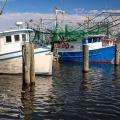Commercial Oyster Industry
Mississippi Commercial Oyster Industry
The annual Mississippi commercial Eastern oyster landings (in million pounds) since 1980 are shown below. There were many years between 1880 and 1948 when data on annual landings were unavailable. The data from 1880 to 1949 were retrieved from the available copies of the annual reports published by NOAA Fisheries. The data from 1950 to 2018 were compiled from the NOAA Fisheries website. No commercial oyster landings have been reported from 2019 to 2022.

Mass mortalities of oysters in the state public reefs and oyster farms were reported with the multiple and prolonged openings of the Bonnet Carre Spillway between March to July 2019. As a result, the state public oyster reefs have been closed to harvesting since then. Except for oyster harvests from off-bottom farms near Deer Island, no commercial landings of oysters were registered between March 2019 and June 2013.

In response to requests by state regulatory agencies and seafood organizations, the 2009 (and later) economic contributions of the Mississippi seafood industry by major species were imputed from state estimates published by NOAA Fisheries. Extension and research publications were developed to document the economic contributions of Mississippi's major seafood species that landed, processed, sold, and consumed.
Sales are the gross sales by businesses within the economic region affected by an activity. Sales, income, value-added, and tax contributions are measured in dollars. Employment or job contribution is expressed in terms of a mix of both full-time and part-time jobs. The total economic contribution is the sum of direct, indirect, and induced contributions.
The economic contributions of the oyster industry in 2009 are shown in the table below. The sales contributions reached $23.72 million in 2009, generating 562 full-time and part-time jobs. The income contribution was $9.0 million, and the value-added created was $11.9 million. The industry added tax impacts, reaching $1.15 million.
| 2009 Economic Impacts of Mississippi Oyster Industry By Sector Without Imports | |||||
|---|---|---|---|---|---|
| Sector | Sales impacts (M$) | Job impacts | Income impacts (M$) | Value-added impacts (M$) | Indirect tax impacts (M$) |
| Harvesting | 9.77 | 199 | 3.02 | 4.38 | 0.30 |
| Processing | 2.62 | 35 | 1.04 | 1.30 | 0.05 |
| Wholesaling | 1.58 | 17 | 0.56 | 0.70 | 0.21 |
| Fish Markets | 0.83 | 20 | 0.41 | 0.50 | 0.12 |
| Restaurants | 8.92 | 292 | 3.97 | 5.02 | 0.48 |
| Total | 23.72 | 562 | 9.00 | 11.90 | 1.15 |
Table 1 shows estimates of the 2009 economic contributions of the Mississippi oyster industry from MAFES Bulletin 1209.
The economic impacts of the Mississippi oyster industry in 2011 are shown in the table below. The industry's sales impact reached $13.47 million in 2011, creating about 354 full-time and part-time jobs in the same year. Income contribution was $5.62 million, and value-added created was $7.18 million. The industry added tax impacts, reaching $1.32 million.
| 2011 Economic Impacts of Mississippi Oyster Industry By Sector Without Imports | |||||
|---|---|---|---|---|---|
| Sector | Sales impacts (M$) | Job impacts | Income impacts (M$) | Value-added impacts (M$) | Tax impacts (M$) |
| Harvesting | 1.51 | 30 | 0.45 | 0.67 | 0.07 |
| Processing | 1.91 | 25 | 0.75 | 0.95 | 0.07 |
| Wholesaling | 1.03 | 11 | 0.37 | 0.46 | 0.11 |
| Fish Markets | 0.68 | 16 | 0.34 | 0.41 | 0.11 |
| Restaurants | 8.34 | 272 | 3.71 | 4.69 | 0.95 |
| Total | 13.47 | 354 | 5.62 | 7.18 | 1.32 |
Table 2 shows estimates of the 2011 economic contributions of the Mississippi crab industry from https://coastal.msstate.edu/oyster-economic-impact.
The 2015 estimates of the economic contributions of Mississippi's combined crab and oyster industries are shown below. Due to the confidentiality of the 2015 data, NOAA Fisheries estimates were combined for the two species. The combined sales contributions totaled $35 million and generated 831 full-time and part-time jobs. Pooled-income contributions were $14.8 million, and the value-added created was $18.9 million.
| Economic contributions of Mississippi oyster and crab industry by sector and type, 2015 | |||||
|---|---|---|---|---|---|
| Sector | Sales contributions (M$) | Job contributions | Income contributions (M$) | Value-added contributions (M$) | |
| Commercial harvesters | 3.4 | 63 | 1.1 | 1.5 | |
| Seafood processors & dealers | 4.0 | 48 | 1.6 | 2.0 | |
| Seafood importers | 0.0 | 0 | 0.0 | 0.0 | |
| Seafood wholesalers & distributors | 3.2 | 31 | 1.1 | 1.4 | |
| Seafood retailing | 24.4 | 689 | 11.1 | 13.9 | |
| Total | 35.0 | 831 | 14.8 | 18.9 | |
Table 3 shows the combined estimates of the 2015 economic contributions of the Mississippi crab and oyster sectors from Extension publication 3194.
Below are the 2020 estimates of the economic contributions of Mississippi's combined crab and oyster industries. Due to the confidentiality of the 2020 data, NOAA Fisheries estimates were combined for the two species. The combined sales contributions totaled $24.6 million and generated 542 full-time and part-time jobs. Pooled-income contributions were $10.4 million, and the value-added created was $15.2 million.
| Economic contributions of Mississippi oyster and crab industry by sector and type, 2015 | ||||||
|---|---|---|---|---|---|---|
| Sector | Sales contributions (M$) | Job contributions | Income contributions (M$) | Value-added contributions (M$) | Percent | |
| Commercial harvesters | 2.1 | 37 | 0.7 | 1.1 | 8.7% | |
| Seafood processors & dealers | 3.1 | 35 | 1.2 | 1.8 | 12.7% | |
| Seafood importers | 0.0 | 0 | 0.0 | 0.0 | 0.0% | |
| Seafood wholesalers & distributors | 2.4 | 21 | 0.8 | 1.2 | 9.6% | |
| Seafood retailing | 17.0 | 449 | 7.7 | 11.1 | 69.0% | |
| Total | 24.6 | 542 | 10.4 | 15.2 | 100.0% | |
Table 3 shows the combined estimates of the 2015 economic contributions of the Mississippi crab and oyster sectors from Extension publication 3194.
Publications
News
RAYMOND, Miss. -- For Mississippi’s commercial fishermen, stress is part of daily life, but the typical stressors they face have been intensifying for more than 10 years.
LAPLACE, La.
While the U.S. Army Corps of Engineers is closing the Bonnet Carré Spillway this week, economic impacts of its months-long opening are expected to be felt in the seafood industry for years to come.




